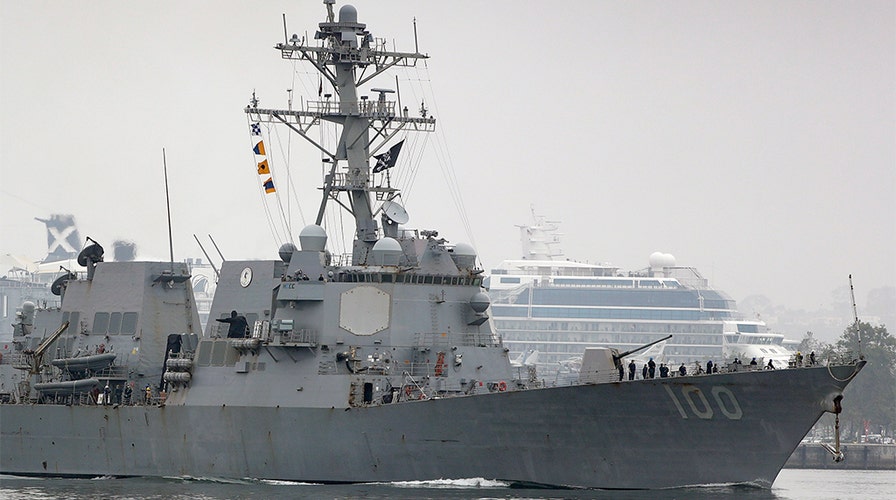Fox News Flash top headlines for May 20
Fox News Flash top headlines are here. Check out what's clicking on Foxnews.com.
The Pentagon’s Defense Innovation Unit (DIU) has made a new deal to develop single-antenna satellite connectivity to operate multiple beams simultaneously and maximize networking among U.S. Navy surface ships.
DIU will, according to a deal with Isotropic, begin prototyping the antenna technology, engineered to support “multiple links over multiple bands of satellite capacity,” including S, C, Ka, Ku, X and Q-band connections. The DIU evaluation will also seek to recreate challenging wartime contingencies such as an ability to operate in rough seas, sustain high winds and function in areas where there may be electromagnetic interference.
Should this new multi-beam forming technology come to fruition, it will bring with it a number of interesting tactical implications; increased bandwidth through multi-satellite connectivity could also enhance functionality of some weapons systems. For instance, the Navy’s ship-launched Maritime Tomahawk can use high-throughput radio signals to help direct a missile toward a moving target at sea. This, of course, brings new attack options for Navy ships which have historically only used Tomahawks against fixed-targets. Improved bandwidth and precise, multi-beam forming connectivity between multiple satellites at once could improve targeting and weapons guidance by, perhaps in some scenarios, handing-off a targeting track quickly from one satellite to another as an incoming threat travels from one region to another; sharing sensor data from one satellite sensing envelope to another in real-time can help share targeting information, track long-range attacks and connect otherwise disparate units to one another. Networking multiple satellites and ship-or-ground-based terminals could bring new advantages for dismounted soldiers as well, many of whom rely upon radio networks across and between swaths of rugged terrain. Other air, ground and ship-fired weapons, such as Hellfire missiles, can draw from RF for targeting guidance.
NAVY ARMS SEA DRONES FOR OCEAN ATTACK
The U.S. military, which is now aggressively preparing for space war, is quickly building and flying new satellites. Some of these include emerging networks of Very Low Earth Orbit (vLEO) satellites, smaller, lower-flying nodes intended to connect to the ground and one another while moving quickly and operating closer to the boundaries of the earth’s atmosphere. This phenomenon, coupled with concurrent Pentagon efforts to build more larger satellites, is intended to not only improve multi-node networking but also facilitate several key elements of the Air Force’s space war strategy -- redundancy, disaggregation and resiliency. The more satellites there are in space ... and the more dispersed or dis-aggregated they are ... the harder it is for an enemy to knock out U.S. operational connectivity. Combat crucial satellite transmissions, including radio, data, video and other networking mediums and guidance systems, can sustain functionality in the event that one is jammed or destroyed by an Anti-Satellite (ASAT) weapon. Therefore, faster, multi-satellite, beam-forming antenna technology ensuring connectivity across multiple nodes in space, can preserve operational necessities such as air-ground connectivity, ship-to-ship radio transmissions and cross-domain networking. While this technology could at the moment be described as nascent or emerging … yet believed to be resilient and highly mature … it could eventually evolve toward having additional space war, weapons guidance, jamming and even missile defense applications.

The USS Kidd flies its traditional skull and crossbones flag while passing downtown San Diego as it returns to Naval Base San Diego, Tuesday, April 28, 2020, as seen from Coronado, Calif. - file photo. (AP Photo/Gregory Bull)
CLICK HERE TO GET THE FOX NEWS APP
“Over the course of the next 10 years, the amount of available options in space for connectivity will be vast, with anywhere between thousands of satellites, to tens of thousands of satellites, operating in different frequencies and different orbits,” Isotropic CEO John Finney said in a Via Satellite essay. “You then have two choices. You either work with the legacy, old generation technology that was never designed for that future. … Or you innovate, to create something that’s purposely designed for the new world of satellites.”

